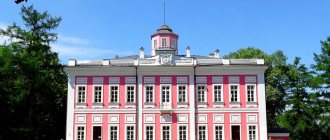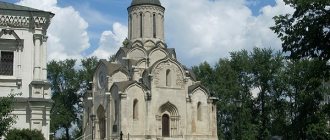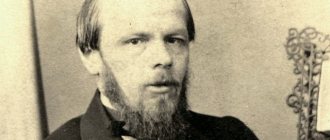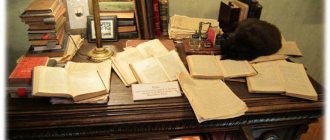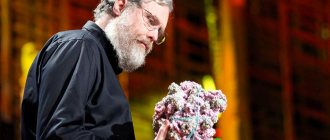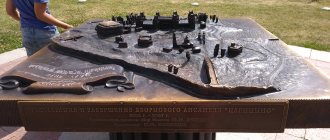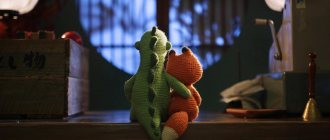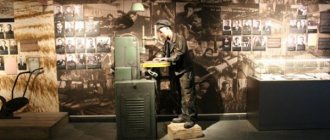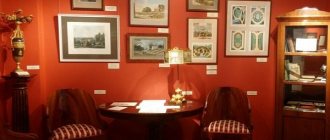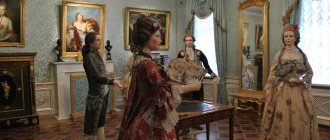Museum of Fine Arts. Pushkin (Pushkin State Museum of Fine Arts named after A. S. Pushkin) is located on Volkhonka Street, opposite the art gallery of I. I. Glazunov. This is one of the largest and most significant art museums in Russia.
The museum opened on May 31 (June 13), 1912; the basis of its collection was copies of ancient sculptures and mosaics, as well as a collection of genuine antiquities purchased by the state from the Egyptologist Golenishchev. Today, the museum's exhibition, housed in several buildings, includes more than 3,000 unique works of painting and sculpture from ancient times to the present day.
The periods of antiquity, the Middle Ages and the Renaissance are most fully represented. Among the most valuable paintings in the Pushkin Museum in Moscow are works by Rubens, Van Dyck, Rembrandt, and Poussin.
A separate Gallery of Art from Europe and America of the 19th and 20th centuries contains a thematic exhibition. In this section of the museum you can get acquainted with various movements of European art and see paintings by Delacroix, Goya, Courbet, Millet, Claude Monet, Renoir, Degas, Cezanne, Gauguin, Van Gogh, Toulouse-Lautrec, Picasso, Kandinsky, Chagall, etc.
© State Museum of Fine Arts named after A. S. Pushkin
The departments of the Museum of Fine Arts in Moscow also include: Department of Personal Collections (currently - only as a site for temporary exhibitions), Central Exhibition Center "Museion", Educational Art Museum named after. I. V. Tsvetaeva, memorial apartment of S. T. Richter.
In addition to the permanent exhibition, the museum hosts temporary thematic exhibitions, events and anniversary events.
Visitors are provided with audio guides in Russian, English, German, French and Italian.
Excursions to the State Museum of Fine Arts named after A. S. Pushkin Buy at
Opening hours of the Pushkin Museum of Fine Arts in 2021
Main building
- Tuesday, Wednesday, Saturday and Sunday 11:00 to 20:00
- Thursday and Friday from 11:00 to 21:00
- Monday - closed
- Box office closes an hour earlier
Gallery of Art of Europe and America of the 19th-20th centuries
- Tuesday, Wednesday, Saturday and Sunday from 11:00 to 20:00
- Thursday and Friday - from 11:00 to 21:00
- Monday - closed
- Box office closes an hour earlier
Museum of Personal Collections (temporary exhibitions)
- The main exhibition is closed until 2023.
Edgar Degas "Blue Dancers". 1897
Edgar Degas.
Blue dancers. 1897 Gallery of American and European Arts of the 19th and 20th centuries. Pushkin Museum im. A. Pushkin, Moscow. From the collection of Sergei Shchukin It is believed that Degas was a painter of dancers. But as he himself stated, he did not love dancers, but movement and beautiful dresses. This is exactly what he looked for in ballerinas.
It may seem to you that there are four dancers dancing in the painting. They don't actually dance. And there are not four of them at all!
Most likely, Degas depicted one girl from different angles. In his archives after his death, they found photographs of the same girl at different moments of movement.
We see how she bent down to adjust her pointe shoe. The next moment she adjusts the straps of her dress. And then she holds on to the decoration to inspect her dress.
Degas achieved the blue radiant color in an unusual way. The picture is painted in pastels. These are something like wax crayons. Degas exposed her to steam.
Under the influence of steam, the pastel softened, and the artist distributed it over the canvas with a brush. This gave her even more shine.
Read about other secrets of the painting in the article “Degas’ Blue Dancers: 5 Incredible Facts about the Painting.”
Ticket prices for the Pushkin Museum of Fine Arts in 2021
Main building
- For adults - 500 rubles
- For children under 6 years old inclusive - free
- For children from 7 to 18 years old - 250 rubles
- For Russian students - 250 rubles
- For citizens of the Russian Federation from 18 to 24 years old inclusive - 250 rubles
- For citizens of the Russian Federation 60 years and older - 250 rubles
Gallery of Art from Europe and America of the 19th–20th centuries
- For adults - 500 rubles
- For children under 6 years old inclusive - free
- For children from 7 to 18 years old - 250 rubles
- For Russian students - 250 rubles
- For citizens of the Russian Federation from 18 to 24 years old inclusive - 250 rubles
- For citizens of the Russian Federation 60 years and older - 250 rubles
How to get to the Pushkin Museum of Fine Arts
Address: Moscow, Volkhonka st., 12.
The nearest metro station is Kropotkinskaya. The museum is located on the opposite side of the Cathedral of Christ the Savior. The museum includes three buildings: the main building, the Gallery of European and American Art of the 19th-20th centuries. and the building of the museum of personal collections. Since the first place on the way from the metro is the Gallery, the sign of which also says that this is the Pushkin Museum, you don’t have to get to the main building and walk around the Gallery. Sometimes there is a queue at the ticket office of the Main building, which can become a landmark for the entrance to the Museum.
To buy a ticket
Online purchase is available on the official website of the museum. This is the only place where you can purchase tickets to the Pushkin Museum without leaving your home; the museum does not have online intermediaries.
Only advance purchase is possible on the website - on the day of the visit, tickets can only be purchased at the museum box office on site.
An electronic ticket gives you the right to skip the queue through a special entrance. Purchases on the site are made no earlier than a month before the visit.
Buy a ticket to the Pushkin Museum online
Story
In 1893, Moscow State University professor, doctor of Roman literature and historian Ivan Vladimirovich Tsvetaev conceived the idea of creating a museum as a textbook on art history - with copies of ancient antique vases, sculptures and other objects. In 1898, its foundation ceremony took place. A significant portion of the money for the construction was contributed by philanthropist Yuri Stepanovich Nechaev-Maltsev. The design competition was won by the self-taught architect P.S. Fighters. The construction was supervised by architect R.I. Klein. Architects I.I. took part in the construction. Rerberg and V.G. Shukhov, as well as many talented masters of that time. The internal layout and plan of the building were created in accordance with the ideas of P.S. Boytsova. And the interiors and facades are the work of R.I. Klein and his assistants.
On May 31, 1912, the Museum of Fine Arts named after Emperor Alexander III was opened. Its first director in 1912–1913 was its founder Ivan Vladimirovich Tsvetaev. In 1932, the museum was renamed the State Museum of Fine Arts, and in 1937 it was named after A.S. Pushkin. During the Great Patriotic War, the exhibits themselves were evacuated to Novosibirsk and Solikamsk. The building, including its glass roofs, was damaged by bombing. After the war, in October 1946, when the building was restored, the opening of the exhibition took place. Since 1980, on the initiative of Svyatoslav Richter and the director of the Pushkin Museum I.A. Antonova hosts the annual music and painting festival “December Evenings”.
In 1985, the Museum of Personal Collections was founded as the scientific department of the Pushkin Museum, designed to preserve the “spiritual connection” between the collection and its former owner. The Pushkin Museum's exhibits are currently being digitized. Passports are created for all exhibits, which are necessary for registration, storage and restoration. The high quality of the electronic copy allows you to record and control the condition of the exhibit, the location and depth of microcracks. In case of restoration it will be possible to restore the item.
LiveInternetLiveInternet
Wednesday, December 09, 2021 08:11 + to the Galyshenka
all posts by the author The famous Pushkin Museum. Part 1 Building The famous Pushkin Museum. Part 2 Tsvetaev's collection of casts from famous works of world sculpture In April 1923, the People's Commissariat of Education decided to create a Central Museum of Old Western Painting in the building of the Museum of Fine Arts based on the collections of the State Museum Fund, the Moscow Public and Rumyantsev Museums, and the collection of the First Museum of Old Western Painting (collection of D. I. Shchukin), collections of G. A. Brocard and other private collections nationalized after the revolution. Throughout the year, paintings were received by the Museum, and in November 1924 the first halls of the new art gallery opened. In 1930, paintings by Botticelli, Cranach, Poussin and David were transferred to the Pushkin Museum from the Hermitage.
Canaletto “Return of Bucintoro to the pier of the Doge’s Palace” Online tours of the Pushkin Museum
Claude Lorrain (Claude Jelle). The Rape of Europa. 1655
James Paterson. Moreton Castle in Scotland (Enchanted Castle). 1896
Fritz Thaulow. Corner of Venice. 1894
Fritz Thaulow. Mountain river. Winter. OK. 1898 It’s easy to imagine how valuable the museum’s exhibits are: Egyptian figurines, Fayum portraits, Western European painting, impressionists, Dutch, Flemings. Therefore, from 1941 to 1944, museum funds were evacuated in Novosibirsk and Solikamsk. True, after that the exhibition stood in the open air for another 3 years, as part of the glass ceilings was broken by the bombing. To this day, in the upper part of the western facade of the museum you can see potholes from German bomb fragments.
Pieter Bruegel the Younger. Winter. Ice skating. Around 1600–1605
Unknown artist of the 17th century. Cupids dancing in a circle. Beginning of the 17th century
Izak Claes van Swanenburg (?). Portrait of a girl. 1584
"Madonna and Child" Lucas Cranach the Elder Lucas Cranach the Elder (1472–1553), Public Domain
"The Annunciation of the Blessed Virgin Mary" by Sandro Botticelli
"The Appearance of Sibylla to Emperor Augustus" by Paris Bordone
Jean-Leon Gerome. King Kandaulus. 1859-1860.
Francois Boucher. Hercules and Omphale. 1732-1734
Peter Paul Rubens, Bacchanalia. OK. 1615.
"Madonna and Child, John the Baptist and Saint George" Paris Bordone
Titian's masterpiece "Behold the Man!" In 1927, the painting was stolen and returned to the museum damaged. Then it was mothballed, and restoration began only in 2021
“Artaxerix, Haman and Esther” Rembrant 1600
Rembrandt Harmens van Rijn After the end of World War II, the Pushkin Museum received most of the paintings from the Dresden Gallery. The unique collection was kept in the Pushkin Museum from 1945 to 1955.
On May 2, 1955, the exhibition “Masterpieces of the Dresden Art Gallery” opened at the Pushkin Museum. Spectators wanting to see the famous masterpieces stood in huge queues; many came several times. In total, the exhibition was visited by 1,200,000 people.
Subsequently, the Dresden Gallery collection was returned to the East German authorities. 65 years ago, the USSR transferred to Germany the masterpieces of the Dresden Gallery, saved by Soviet soldiers from destruction. These are “The Sistine Madonna” by Raphael, “Sleeping Venus” by Giorgione, “Denarius of Caesar” by Titian, “Portrait of a Boy” by Pinturicchio and many other outstanding works.
However, some valuables that belonged to West German museums and private collectors remained in the Pushkin Museum.
Eberswaal treasure Includes 81 items (8 chased gold bowls, hryvnias, ingots and a large number of coils of gold wire) with a total weight of 2.59 kg. Belongs to the late Bronze Age - X-IX centuries. BC e. Was gayden on the territory of Germany. Until 1939 it was exhibited in the Berlin Collection of Prehistoric Art. In 1945, the Eberswald treasure was removed as trophy art by the Soviet authorities; was in the Pushkin Museum of Fine Arts, but is not included in the permanent exhibition to this day.
At the same time, the unique treasure of Priam, found by Heinrich Schliemann during the excavations of ancient Troy, came here. The gold was considered lost, but in fact it was taken from Germany to the Soviet Union after World War II and kept in the strictest secrecy in the museum's storerooms. Only in 1993 was it officially announced that the treasures were in Moscow, and since 1996 the legendary treasure began to be exhibited in the Pushkin Museum. gold covering the child's body
Portrait of a young man in a golden wreath Fayum portrait In 1948, the State Museum of New Western Art (GMNZI) was closed, and its collection was divided between the Pushkin Museum and the Hermitage. As a result, the Pushkin Museum received most of the collections of Moscow merchants Sergei Shchukin and Ivan Morozov, confiscated by the Soviet authorities, consisting of paintings by Renoir, Van Gogh, Monet, Degas, Cezanne, Matisse, Picasso and other Western European and American masters of the late 19th - early 20th centuries (about 300 paintings and over 60 sculptures). These were mainly works by French impressionists and post-impressionists, which are now the pride and basis of the Pushkin Museum’s exhibition. The museum contains paintings “Red Vineyards in Arles” by Van Gogh and “Girl on a Ball” by Pablo Picasso that belonged to Ivan Morozov.
Edgar Degas "Blue Dancers"
Edgar Degas. Dancer at the photographer (Dancer in front of the window). 1875
Paul Cezanne "Pierrot and Harlequin" 1888
Pablo Ruiz Picasso. Harlequin and his girlfriend (Traveling Gymnasts). 1901
Pablo Ruiz Picasso "Girl on a Ball", 1905
Mary Cassett. Mother and child. 1893
Pierre Auguste Renoir. Swimming on the Seine (Splash Pool). 1869
Claude Monet. Breakfast on the grass. 1866
Alfred Sisley. Hoschede Garden. Montgeron. 1881
Alfred Sisley. Frost in Louveciennes. 1873
Edward Vuillard. In the garden. Around 1898
Vincent van Gogh. “Portrait of Doctor Ray” 1889 is the only portrait by Van Gogh in Russian collections.
Vincent van Gogh. Landscape in Auvers after the rain (Landscape with a cart and a train). 1890
Vincent van Gogh. "Red Vineyards in Arles" 1888
Drying the sails. Andre Derain.
Paul Gauguin. Te arii vahine. Queen (King's Wife). 1896
Henri Matisse. View from the window. Tangier (Moroccan triptych). 1912
Toulouse Lautrec Yvette Guilbert
Auguste Renoir
Auguste Renoir Portrait of Jeanne Samary 1877 In 1987, the Pushkin Museum received building No. 14 for exhibiting personal collections. The initiative to create this museum belongs to the researcher of the history of Russian culture I.S. Zilberstein. He personally collected more than 2,300 works of art from Western Europe and Russia.
Henri Rousseau. Jaguar attack on a horse. 1910
Henri Rousseau. View of Montsouris park. 1910
Edvard Munch. White Night. Osgardstran (Girls on the Bridge). 1902-1903
Maurice Denis. Green seashore. Perrot-Guirec. 1909
Rockwell Kent. Adirondack farm. Winter. 1959
Utagawa Toyokuni II. Actor Bandō Mitsugorō III. OK. 1825–1830 As of 2018, the exhibition consists of more than 700 thousand items and includes a collection of casts from ancient statues, works of art, archaeological finds, as well as a collection of objects from Ancient Egypt and Ancient Rome. https://kazanocheka.livejournal.com/85870.html https://twitter.com/theartsmuseum/status/1141680604670582786/photo/1 https://www.culture.ru/themes/255729/onlain-ekskur...r= https%3A%2F%2Fzen.yandex.com
Series of messages “Museums of Fine Arts”:
Part 1 - Alphonse Mucha (Part 4) Part 2 - Russian Museum. Collection of icon paintings. Photo selection1. ... Part 42 - Tretyakov Gallery with Khabensky / Tour of the masterpieces of the 20th century Part 43 - The famous Pushkin Museum. Part 1 Building Part 44 - The famous Pushkin Museum. Part 3 Pearls of the collection Part 45 - The famous Pushkin Museum. Part 4 Permanent director and president Irina Antonova
| Categories: | history/Museums painting, graphics, watercolor culture |
Tags:
museum Pushkin museum paintings masterpieces
Cited 13 times Liked by: 26 users
Like share
0
Like
- 26
I liked the post - Quoted
- 0
Saved
- Add to quote book
- 0
Save to links
Liked26
0
Pushkin Museum - exhibits
The collection of the Pushkin Museum contains works by Western masters from antiquity to the 20th century. Each of the halls is dedicated to a specific era. The entire collection contains about 670 thousand works of exhibits, but only 1.5% of the funds are available to the general public. The ground floor mainly houses antiquities. The Egyptian Hall is located here. Also presented are objects of ancient peoples who inhabited Western Asia and the Mediterranean, the Indian Peninsula and Latin America. One of the most unique exhibits is a unique treasure discovered by the German archaeologist Heinrich Schliemann during his excavations in Troy in 1871–1890. This treasure was considered lost during World War II. It later turned out that, along with other trophies, it was taken from Germany to the Soviet Union and was kept in the strictest secrecy in the storerooms of the Pushkin Museum.
The halls on the second floor display more than a thousand exhibits from ancient Greece and Rome. These are antique amphorae and ceramics, sculpture. Here are copies of the most famous sculptures of antiquity. Visitors will see items from the Middle Ages and the Renaissance. Works by 19th and 20th century masters are on display, as well as a large collection of French Impressionist and Post-Impressionist artists, including works by famous artists such as Matisse and Picasso, Gauguin and Van Gogh. The collection of Byzantine icons occupies a special place. You can see works by European masters such as Cranach, Botticelli, Poussin and David. The pearls of the collection are the icons “Madonna and Child Enthroned” and “Madonna and Child and Two Donors”. Many of the items ended up in the Moscow State Institute of Fine Arts after the Great Patriotic War, including those from the Dresden Gallery. The Northern Renaissance is presented in the room entitled "Art of Germany and the Netherlands of the 15th and 16th centuries." Works by Rembrandt and his students are displayed in the hotel exhibition. Dutch school of the 17th century. The “Italian Courtyard” and “Greek Courtyard” halls are especially popular. The "Greek Courtyard" has a three-level floor that conveys the architecture of the Athenian Acropolis. And the “Italian Courtyard” hall repeats the courtyard of Palazzo Bargelo with a corner staircase and small columns supporting a balcony, a light arcade and a well in the center. At the Pushkin Museum, many exhibits are not taken out of the storerooms, since there are standards according to which the placement and storage of exhibits is determined. The museum exhibition is constantly changing, since all exhibits cannot be displayed to visitors at the same time. There are also exhibitions of masterpieces from the world's largest art galleries.
Museum exposition
The exhibition halls are located on two floors. Today, the museum’s halls contain more than 3,000 unique exhibits.
The Egyptian Hall deserves special attention, where one of the best and richest collections in the world dedicated to Ancient Egypt is presented. Visitors to the Pushkin Museum in Moscow can see mummies, sarcophagi, statues, as well as ancient jewelry and household items.
One of the halls on the ground floor is completely devoted to the exhibition of exhibits of the ancient Near East. In the exhibition halls of the museum you can see objects from ancient Italy, Cyprus and Rome, as well as exhibits found during excavations of the Bosporan kingdom. Separate rooms are dedicated to the Renaissance.
One of the exhibitions allows you to study various movements of European art. Here you can see works by Goya, Delacroix, Monet, Renoir, Van Gogh, Picasso and other great people.
On the second floor of the museum there is the “Olympic” hall, where ancient Greek sculptures are exhibited. The most significant exhibit of this hall is a copy of the Capitoline she-wolf, which fed Romulus and Remus, who founded Rome, with its milk. The original sculpture is in the Capitoline Museum in Rome.
Photography without flash is allowed in the Pushkin Museum.
In addition to the permanent exhibition, various thematic exhibitions and cultural events are organized on the territory of the museum.
Museum visitors can use an audio guide for an additional fee.
Museum of Fine Arts named after A.S. Pushkin - information for tourists
The divisions of the Pushkin Museum are the Educational Art Museum named after I.V. Tsvetaeva and Memorial Apartment of Svyatoslav Richter. The Museion Center for Aesthetic Education of Children and Youth has been created, which organizes exhibitions and meetings with artists, performances and musical concerts. State Museum of Fine Arts named after A.S. Pushkin offers lectures, excursions and study groups. More than 15 different routes have been developed that allow you to view exhibits created by masters of various historical periods. Excursions with a guide in Russian and foreign languages are organized for visitors. For convenience, it is possible to present transport services - cars and buses. Audio guide services are available. Excursions to the Museum of Fine Arts named after A.S. Pushkin can be booked.
Tickets - price and purchase
Currently, buy tickets to the State Museum of Fine Arts named after A.S. Pushkin is only possible through the official website. Sales through cash registers are temporarily unavailable. Due to restrictions on the number of visitors, tickets are sold for a specific time.
Prices
400 rub . - full ticket. For all citizens except the categories listed below.
200 rub . - discount ticket. Who is eligible to purchase:
- Pensioners (age 60 years and older);
- Students;
- Members of large families;
- Members of the Union of Artists of the Russian Federation;
- Members of the Association of Art Critics of the Russian Federation;
- Members of the Russian Academy of Arts.
1 rub . Who is eligible to purchase:
- Persons under 18 years of age;
- Disabled people of groups I and II and persons accompanying them;
- Students studying in specializations: fine arts, architecture;
- Employees of state museums of the Russian Federation;
- Employees of the Ministry of Culture of the Russian Federation;
- Official representatives of the media;
- Military personnel of the Russian Federation undergoing military service;
- Heroes of Russia, Heroes of the Soviet Union, Knights of the Order of Glory;
- Citizens who took part in eliminating the consequences of the Chernobyl disaster;
- Veterans and disabled people of the Great Patriotic War, combat veterans (RF and CIS).
To buy tickets
Purchase through the official website of the Pushkin Museum. Select visiting time and categories:
Note: On the same page of the website you can purchase subscriptions and tickets for excursions.
